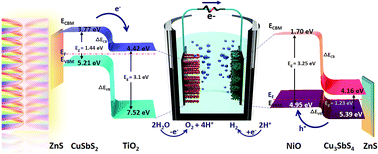Unassisted visible solar water splitting with efficient photoelectrodes sensitized by quantum dots synthesized via an environmentally friendly eutectic solvent-mediated approach†
Abstract
Deep eutectic solvents (DESs) based on choline chloride/ethylene glycol have been explored as synthetic media for recently introduced Cu–Sb–S based colloidal quantum dots (CQDs) decorated on NiO/fluorine-doped tin oxide (FTO) and TiO2/FTO photoelectrodes for unassisted solar water splitting for hydrogen generation. The feasibility of the use of an environmentally benign solvent-based synthetic process is demonstrated herein by preparing the earth-abundant Cu–Sb–S-based CQDs and utilizing them in a solar energy harvesting material for photoelectrochemical (PEC) water splitting while avoiding the use of sacrificial agents. The band alignment between CQDs and NiO or TiO2 clearly suggests that the CQD-modified NiO and TiO2 electrodes act as a potential photocathode (NiO/Cu3SbS4/ZnS) and photoanode (TiO2/CuSbS2/ZnS) with faradaic efficiencies of up to 74 and 86%, respectively, which allows us to construct an efficient PEC cell to split water at an overall solar-to-hydrogen (STH) efficiency of ∼0.28%. The tandem photoelectrode configuration in an unassisted mode of solar-driven water splitting based on a wire-linked system shows ∼0.97 mA cm−2 of current density, and can split water under zero-bias conditions. Enhancement of the PEC device by accelerating electron and hole transport and broadening the diffusion length using photosensitizer materials while avoiding typical recombination with a thin passivation layer was achieved. The charge transport mechanism through combining experimental results in half and overall water splitting reactions is proposed. The success of such efficient multi-layered heterojunction photoelectrodes is essential for the future development of green energy harvesting devices.



 Please wait while we load your content...
Please wait while we load your content...